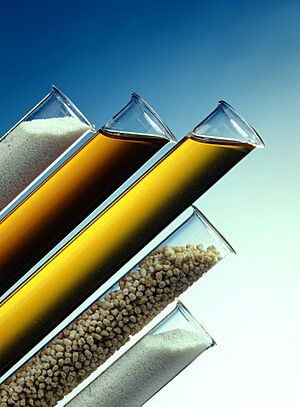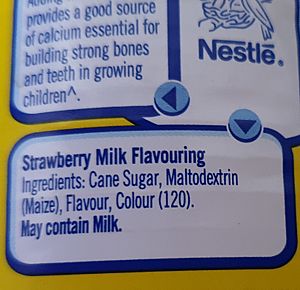Food additive facts for kids


A food additive is a substance added to food to make it better in some way. People have used food additives for hundreds of years. For example, salting fish helps keep it fresh, and using vinegar to preserve vegetables (called pickling) also makes them last longer. Another common use for additives is to give food a nice color.
Sometimes, substances can get into food indirectly during the manufacturing process, from packaging, or while food is stored or transported. These are called "indirect additives."
What Are E-Numbers?
To help control and identify food additives, each approved additive is given a special number. In Europe, these are called "E numbers" and always start with the letter "E." For example, acetic acid is known as E260 in Europe.
In countries outside Europe, people often use just the number without the "E" prefix. So, acetic acid might just be called additive 260. Some additives, like alkannin (additive 103), are approved in places like Australia and New Zealand but not in Europe, so they don't have an E-number. Since 1987, Australia has required packaged foods to list additives by name or number.
In the United States, the Food and Drug Administration (FDA) lists many additives as "generally recognized as safe" (GRAS). These are listed with their chemical number and under FDA rules.
Types of Food Additives
Food additives can be grouped into different types based on what they do. Some additives can even fit into more than one group. For example, salt is both a preservative and a flavor.
Here are some common types of food additives:
- Acidulants
- These additives make food taste sour or acidic. Examples include vinegar, citric acid, and lactic acid.
- Acidity regulators
- These help control the pH level of foods. This is important for keeping food stable or for helping enzymes work correctly.
- Anticaking agents
- These stop powders, like milk powder, from clumping together.
- Antifoaming and foaming agents
- Antifoaming agents reduce or prevent foam in foods. Foaming agents do the opposite, helping foods create foam.
- Antioxidants
- Like vitamin C, these additives help keep food from spoiling by stopping oxygen from damaging it.
- Bulking agents
- Additives like starch increase the amount or "bulk" of a food without changing its taste.
- Food coloring
- These are added to food to bring back colors lost during cooking or to make food look more appealing.
- Fortifying agents
- These include vitamins, minerals, and other dietary supplements that increase the nutritional value of food.
- Color retention agents
- Unlike colorings, these additives help keep a food's natural color from fading.
- Emulsifiers
- These allow water and oils to mix together smoothly, like in mayonnaise, ice cream, and homogenized milk.
- Flavors
- These additives give food a specific taste or smell. They can come from natural ingredients or be made artificially.
- Flavor enhancers
- These make a food's existing flavors stronger. A well-known example is monosodium glutamate.
- Flour treatment agents
- These are added to flour to make its color better or to improve how it works in baking.
- Glazing agents
- These give foods a shiny look or a protective coating.
- Humectants
- These additives help prevent foods from drying out.
- Preservatives
- These stop or slow down food spoilage caused by fungi, bacteria, and other tiny living things (microorganisms).
- Stabilizers
- These, along with thickeners and gelling agents (like agar or pectin used in jam), give foods a firmer texture. They also help keep mixtures like emulsions stable.
- Sweeteners
- These are added to foods for a sweet taste. Sweeteners other than sugar are often used to keep the food energy (calories) low, or because they are better for people with diabetes mellitus or for preventing tooth decay.
- Thickeners
- These substances make a mixture thicker without changing its other main properties.
- Packaging additives
- Some substances used in packaging can get into food. These are considered indirect additives.
Related pages
See also
 In Spanish: Aditivo alimentario para niños
In Spanish: Aditivo alimentario para niños

